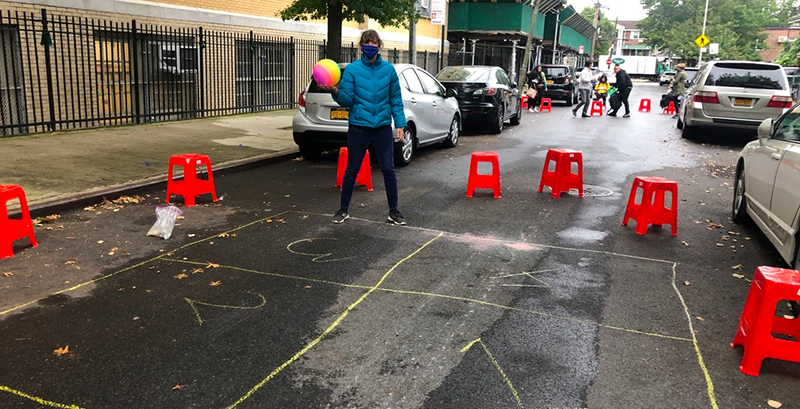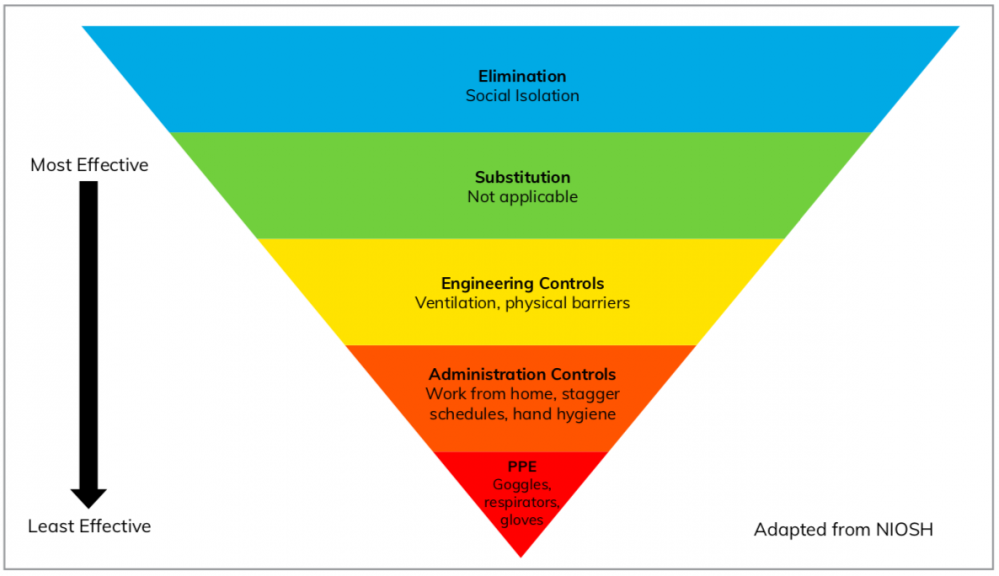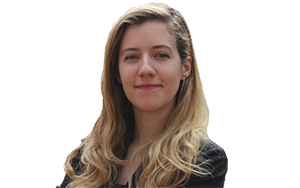The Air They Breathe: NYC Teachers’ School Ventilation Complaint Spotlights Complex Challenge

Updated, Sept. 21
Less than a week after students in the nation’s largest school district returned for in-person learning, 46 teachers from nine schools in Queens, the Bronx and Manhattan filed a complaint with the New York State Department of Labor, asking authorities to investigate ventilation across city schools.
The teachers are represented by attorneys from the non-profit Public Employees for Environmental Responsibility and the Environmental Justice Initiative, the group that was one of the first to sound the alarm about dangerous airborne carcinogens in the days after 9/11.
“We’re not against the schools reopening. We just want safe schools,” said Joel Kupferman, head of the justice initiative and one of the lawyers spearheading the case. “The school system didn’t fix [ventilation] for decades. We’d like to know how they fixed it in one week.”
The charge spotlights a question that some say hasn’t yet been fully resolved: whether all of the school buildings the city has approved for use are really safe during the pandemic. Early data from the city’s testing effort has revealed a very small positive case count: just 20 staffers and eight students out of 16,298 results. But in some neighborhoods, the percentage of individuals testing positive remains above 3 percent. Some hot spots throughout the city are “not moving in the right direction,” Mayor Bill de Blasio said Friday.
The city’s ventilation problem received ample attention over the summer as the DOE and the teachers union squared off over reopening plans, but has since faded into the background amid a host of other issues, including teacher shortages and 77,000 missing internet devices. But as winter approaches and the U.S. enters into a third wave of COVID-19 infections, experts say lingering questions about air quality should be addressed.
Ventilation ranks highly on the to-do list for reducing the risk of airborne coronavirus transmission in schools, according to the American Industrial Hygiene Association. “As the nation moves to restart the economy and in-person education, we must seriously consider and adopt effective engineering controls in public buildings in order to protect the health of employees and occupants,” the authors of one paper published in August write. “Scientifically proven methods to control the spread of airborne diseases that include enhanced ventilation with outdoor air and high efficiency filtration have not been widely implemented outside of healthcare facilities.”

Incorporating such controls is ultimately a good investment, the authors point out. “Compared to solutions relying mostly or exclusively on PPE, engineered solutions remove the onus from individuals and their personal habits or attentiveness,” they write. “Machines do not get tired, sloppy, or distracted.”
Teaching class in the street
Most of the staff in the labor department complaint requested anonymity out of fear of reprisal from the NYC Department of Education, Kupferman said. Some are among the 23 percent of the city’s roughly 75,000-member teacher corps who have been granted medical accommodation to work from home. Those accommodations expire at the end of December, according to the complaint, and teachers are worried their status could change.
The DOE did not respond to requests for comment.
“Many of these teachers are very concerned about their students,” said Kupferman. “We’ve been hearing from parents that they’re concerned their kids are going to schools with possible exposure and coming home. Many have extended family, like vulnerable grandparents, at home. It puts them in needless danger.”
The majority of the district’s 1.1 million students have opted for full-time remote learning, while just under half are enrolled in the blended model, where they spend one to three days a week in school and the rest learning virtually from home
Back in September, as pressure from the United Federation of Teachers mounted, the DOE conducted its own ventilation inspections and posted the findings online. The School Construction Authority and evaluators from third-party agencies performed the review, which for each school building showed the number of rooms with at least one openable window, as well as the number serviced by supply fans, exhaust fans and unit ventilators.
The DOE reports were not comprehensive, Kuperfman said. While they provided information about classrooms, they didn’t address ventilation in all hallways, auditoriums, cafeterias — and in the case of some schools — bathrooms.
Amanda Vender, one of the named teachers in the complaint, is an English as a New Language teacher at the International High School for Health Sciences in Queens. About 60 percent of the school’s 267 students have selected blended learning. The school, which is co-located with a much bigger one, Newtown High School, doesn’t have an HVAC system. According to the DOE’s report, nearly all the rooms surveyed lack operational supply fans, and over half lack operational exhaust fans. Just over 92 percent don’t have operational unit ventilators.
Neither the DOE’s report nor the UFT’s instilled much confidence, Vender said. First came the UFT checklist. The initial thing she noticed upon reading it was that it contained fewer than the anticipated 50 items. She was also struck by a few notes specifically pertaining to air quality. “It cited some ventilation concerns in our building,” Vender recalled. “The teachers responded to this and said, ‘This doesn’t sound good.’ The UFT downplayed it and said, ‘No, it’s OK. We’re fixing those things,’ and, ‘It’s OK, the building is safe.'”
A couple of the items on the checklist referred to a different, 16-page document. “We asked, ‘Where is the 16-page document referenced in the checklist?'” Vender said. “And we were told by the UFT, ‘That’s internal.’ That raised questions for us. Internal, as I understood it, for the DOE and the UFT, but not for us members.”
The room where Vender is supposed to teach her 9th- and 10th-graders has windows, one of which opens only 7 inches, and an exhaust fan under her desk, which isn’t operational. The school is one of over 1,100 that have been granted permission to do outdoor learning, so Vender’s been holding class in the street. On some days, she teaches in-person students there; on others, she uses the space to instruct her remote kids from afar.
“Earlier this week, it rained,” she said Thursday. “I was out on the sidewalk teaching my students at home. My computer was getting a little bit wet, but I feel this is what I need to do to be safe.”
The UFT hasn’t publicly released the findings of its own investigation. One safety report shared with The 74 had 48 questions; another had 45. One specifically asked whether there was sufficient ventilation in the nurse’s office; the other didn’t.
One question both reports had in common was, “Do all classrooms have access to operable windows?” But a “yes” response to that question isn’t sufficient, according to the attorneys.
“The mere ability of air being able to flow in and out of a room or building does not render that room or building safe,” they say in the complaint. “Rather, sufficient airflow and high efficiency filters are necessary to reduce the risk of virus transmission.”
Wide open windows in November
Neither the DOE nor the UFT reports offer three key metrics that Kupferman and Monona Rossol — an industrial hygienist who has long evaluated air quality on behalf of entertainment unions — say are critical in determining safety: ACH (air changes per hour), the percentage of outdoor air in a given space, and the rating of the filter present. Experts have recommended the use of filters with at least a MERV-13 rating, which are now in such high demand that vendors have likened their popularity to “toilet paper in April.”
Three major organizations promoting safe air quality — ASHRAE, the AIHA and ACGIH — have highlighted those same metrics in recent reports about COVID-19.
“If [the DOE] did fix the schools, we’d assume they’d be happy to share that data,” Kupferman said.
The DOE’s reports grew shorter over time, he said. Early iterations of the forms had space for evaluators to take notes about vents. Later, Kupferman said, that became a binary, yes-no question.
“The results of those inspections are seemingly subject to change without notice and their methodology, to the extent it is available, is unsound,” he writes in the complaint. “All nine facilities discussed [here] displayed a different set of data just one week ago.”
“You can’t just check for vents and wave a magic wand and say it’s safe,” said Kupferman, saying he was surprised the UFT hasn’t been more vocal about the DOE reports.
UFT spokesperson Alison Gendar said, “While testing has shown that infection rates in schools have so far remained low, we have urged the DOE to closely monitor air quality in these and other schools.”
As for the sought-after MERV 13 filters, Robert Troeller, president of the custodial supervisors union, said most of the city’s roughly 1,800 schools can’t handle them because of their age. “You can’t just put a heavy duty filter on a system that’s not designed for it,” he said.
Troeller said the school custodians have also been given CO2 monitors to gauge carbon dioxide levels and determine air flow when people are in the building, but haven’t received “clear guidance on what the reading should be.”
“It’s a new tool [custodians] haven’t used in the past,” Troeller said. “They’re still not exactly clear on what’s acceptable. They know how to take a reading, but they’re not certain what the readings mean.”
Fewer than half of NYC’s schools have HVAC systems. The rest are naturally ventilated.
While open windows might have been helpful so far, Kupferman said, using them is going to become more problematic. “You can’t have a classroom with wide open windows in November because of discomfort with temperature. We have trouble with naturally ventilated schools now. Our reservations increase tenfold as it gets colder.”
During an outdoor advisory meeting last week, temperatures began to dip, and some of Vender’s students told her they were getting chilly. “There have been days when it’s been cold in the building, and it’s only October,” the teacher said. “It’s only going to become more uncomfortable.”
‘This is not simple’
The city has also delivered portable air filtration units to some schools. But officials haven’t provided numbers on the total purchased, and Rossol, the industrial hygienist, warns that while the units are a start, they’re no panacea. Using these to fix air quality in a school with systemic ventilation problems is like “shooting elephants with a pea shooter,” she said.
She added that estimates of the device’s effectiveness are often based on studies of rooms with 8-foot ceilings. Many city schools, built over a century ago, have much higher ceilings than that, she said.
“This is not simple,” Rossol said. “You don’t just throw a couple of these in a room. You need to know about air current front-to-back. You have to go room by room.”
The necessary evaluation processes are scientifically complex, and the cost of conducting them and making the appropriate fixes can add up, Rossol said.
The standards Rossol’s recommending have been achievable in the entertainment industry, where she’s done much of her work, because of access to financial resources the public schools don’t have. In a September op-ed, actress, advocate and former gubernatorial candidate Cynthia Nixon addressed the disparity between the attention ventilation is getting on her TV set versus her 9-year-old son’s city school.
“Air purifiers have been purchased, filtration systems have been upgraded, and an entire department has been created solely to deal with safety protocols and testing,” Nixon writes. “…The care and investment given to restarting television and film production in New York looks nothing like the uncertain, chaotic, shamefully underfunded and profoundly unsafe approach to reopening the public schools…”
Kupferman is hopeful that the state will intervene quickly, but said his team will pursue litigation if it does not.
In the meantime, Vender has ordered a heavy winter jacket and a pair of fingerless gray gloves so that she can keep using her computer outside.
“We haven’t had any major investment in public schools for a long time,” she said. “It’s ultimately better to be learning indoors, where kids can have a notebook or a computer at the ready, rather than being outside balancing a computer or notebook in their lap. As it gets cold, we’re all just taking things day-by-day.”
Get stories like these delivered straight to your inbox. Sign up for The 74 Newsletter

;)
